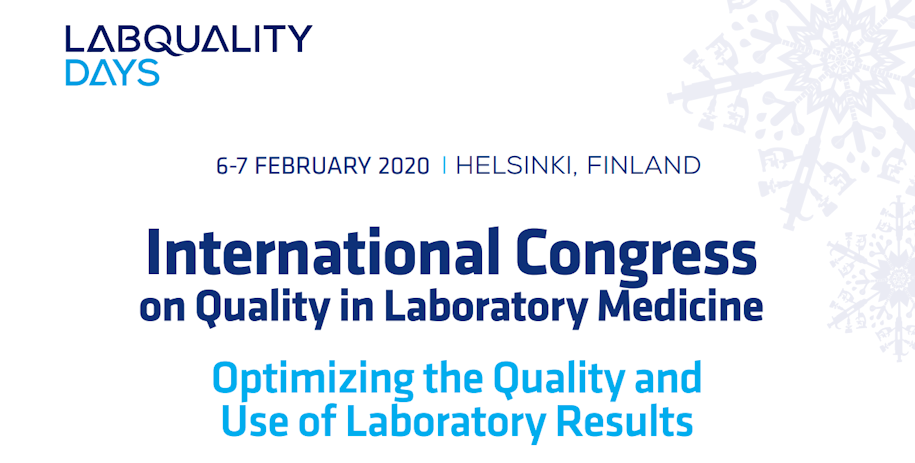Determination of Sigma Score Based on Biological Variation

Piet Meijer from the Netherlands is giving a presentation about using biological variation based quality goals at The International Congress on Quality in Laboratory Medicine 2020. Dr. Meijer summarizes that the application of six-sigma to biological variation (BV) derived analytical performance specifications is hampered by the large variation in published BV data. In this presentation the consequences for the application on quality control rules will be demonstrated. In addition, the six-sigma concept is based on requirements for monitoring, while many laboratory tests are mainly used for diagnostic purposes. Therefore a fit-for-purpose APS is needed to achieve clinically relevant quality goals.
About the Speaker: Piet Meijer
 Piet Meijer is trained as biochemist and has worked for more than 25 year for the Dutch research organisation TNO in the field of cardiovascular research. He has been the head of the coagulation laboratory and developed a special interest in method standardisation and quality issues. His PhD-thesis was entitled “Quality Assessment of Haemostasis Assays”. In 1995 he became part-time involved in the External Quality Assessment (EQA) programme of the ECAT Foundation, a large international EQA provider in blood coagulation. Since 2007 he is fulltime director of this organisation. He has contributed to more than 75 peer-reviewed publications. He is member of several (inter)national societies in the field of thrombosis and haemostasis as well as laboratory haematology and clinical chemistry. He has been member of the board of EQALM (European Organisation for EQA Providers in Laboratory Medicine) and served also two year as chairman of this board. Since January 1st, 2016 he is re-elected in the board of EQALM. From 2004 till 2016 he has been the chair of the Working Group of Haemostasis of this organisation and recently he is elected as the chair of the Scientific Committee of EQALM. He has also been advisor for the CLSI Consensus Committee on Haematology. Currently he is also member of the EFLM (European Federation of Laboratory Medicine)/EQALM Post-analytical Working Group. Furthermore, since 2016 he is member of the steering committee for laboratory guidelines in haemostasis of the International Council for Standardization in Haematology (ICSH) and also member of the Executive Board of the External Quality Assurance in Thrombosis and Haemostasis organisation (EQATH).
Piet Meijer is trained as biochemist and has worked for more than 25 year for the Dutch research organisation TNO in the field of cardiovascular research. He has been the head of the coagulation laboratory and developed a special interest in method standardisation and quality issues. His PhD-thesis was entitled “Quality Assessment of Haemostasis Assays”. In 1995 he became part-time involved in the External Quality Assessment (EQA) programme of the ECAT Foundation, a large international EQA provider in blood coagulation. Since 2007 he is fulltime director of this organisation. He has contributed to more than 75 peer-reviewed publications. He is member of several (inter)national societies in the field of thrombosis and haemostasis as well as laboratory haematology and clinical chemistry. He has been member of the board of EQALM (European Organisation for EQA Providers in Laboratory Medicine) and served also two year as chairman of this board. Since January 1st, 2016 he is re-elected in the board of EQALM. From 2004 till 2016 he has been the chair of the Working Group of Haemostasis of this organisation and recently he is elected as the chair of the Scientific Committee of EQALM. He has also been advisor for the CLSI Consensus Committee on Haematology. Currently he is also member of the EFLM (European Federation of Laboratory Medicine)/EQALM Post-analytical Working Group. Furthermore, since 2016 he is member of the steering committee for laboratory guidelines in haemostasis of the International Council for Standardization in Haematology (ICSH) and also member of the Executive Board of the External Quality Assurance in Thrombosis and Haemostasis organisation (EQATH).
Abstract: Determination of Sigma Score Based on Biological Variation: Fit-for-Purpose for Daily Practice?
It is the responsibility of laboratories to deliver accurate and reproducible test results in order to support the physician in proper decision making. For monitoring the quality of laboratory testing both internal and external quality control processes are used. This provides the laboratory professional with data about the precision and accuracy of testing. In combination precision and accuracy can be expressed in the total error. The appropriateness of the level of imprecision and accuracy can be considered by using performance specifications. For total error this is expressed as the total allowable error. The most widely used performance specifications for precision, accuracy and total error are based on the biological variation.
Today Sigma Metrics, also known as Six Sigma, have become more and more a tool for expressing the appropriateness of the quality of laboratory testing. Sigma Metrics is also used to design quality control processes. The most widely concept of Six Sigma is based on the combination of the total allowable error, precision and accuracy.
Sigma = (TEa – Bias) / SD or Sigma = (%TEa – %Bias) / %CV
A prerequisite for the calculation of the sigma value is the use of reliable data on biological variation. For many parameters a variety on biological variation data has been published. It is therefore the question of currently the determination of the sigma score based on the biological variation is fit-for-purpose. In a recent study this has been investigated for some parameters in the field of blood coagulation [1]. Three laboratories using different instruments and reagents calculated sigma scores for their prothrombin time (PT), activated partial thromboplastin time (APTT), fibrinogen and antithrombin (AT) measurements. Sigma scores were calculated using biological variation (BV) data from the literature in combination with internal and external QC data. Internal data were derived from one quality sample in the normal range collected in three consecutive months and external data were based on 6 external quality surveys with 2-3 data points per survey.
Wide ranges in sigma scores for the PT (0.1-6.8), APTT (0.0-4.3), fibrinogen (1.5-8.3) and AT (0.1-2.4) were observed when QC data was combined with the minimum, median and maximum value of BV data, due in particular to a large variation in within-subject and between-subjects coefficients of variation. When the median BV values were applied, most sigma scores were below 3.0, for internal QC data; 75% and for external QC data; 92%.
These findings demonstrate that: 1) The sigma scores for common haemostasis parameters are relatively low and 2) The application of the six-sigma method to BV-derived APS is hampered by the large variation in published BV data. An updated database is needed, in which only BV studies are included which fulfill standardised criteria. Since the six-sigma concept is based on requirements for monitoring, and many haemostasis tests are only designed for diagnostic purposes, a fit-for-purpose APS is needed to achieve clinically relevant quality goals.
Labquality Days – International Congress on Quality in Laboratory Medicine
Welcome to the International Congress on Quality in Laboratory Medicine on 6-7 February 2020. The scientific program of the next International Congress on Quality in Laboratory Medicine will be built around the theme of optimizing quality. The program covers the topics on harmonization of medical practices, how to communicate the results to clinicians and patients and the quality assurance of new measurement technologies. Welcome to Helsinki!


